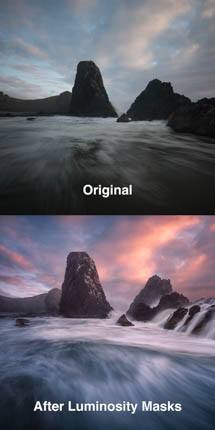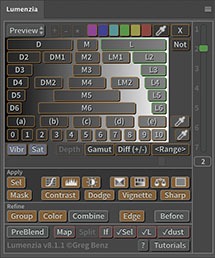[Update to this post: Lumenzia version 4 is now available.]
I’m excited to announce that version 3.0 of my Lumenzia luminosity masking panel is now available. This is the eleventh major update, and the most ambitious yet! It’s also a free upgrade for all Lumenzia customers. This newest update includes dozens of enhancements (over 50 total), but I’m just going to focus on three in this post. Please see the release notes for a full list of changes.
BlendIf Luminosity Masking
Nearly all of Lumenzia’s masks may now be created as BlendIf masks! I’m not talking about a simple highlight or shadow option, but a completely full range of masks created with BlendIf with a simple click or two. Even if you’re familiar with BlendIf, you probably haven’t used them this way, and it probably took you a lot of time to tweak the results. This completely novel approach to luminosity masking offers a couple of huge advantages over using layer masks:
- First, BlendIf masks do not increase file size at all. By comparison, a single layer mask on an image from a Nikon D810 may increase the size of a TIF file by about 70MB. That quickly adds up to gigabytes of savings across your images, even if you only use it occasionally.
- Second, BlendIf masks are dynamic. If the underlying layers are changed, the mask is automatically updated. This prevents a lot of rework. For example, if you clone out a dust spot, you won’t need to recreate the mask to clone the dust out of it too – it will always be up to date.
These masks can be based on either “this” or the underlying layers, and can be customized as much as you like. And Lumenzia includes a visualization feature that lets you see exactly where the BlendIf is being applied (even if it’s based on “this” layer, which can’t be shown with an overlay effect).
BlendIf masks are an excellent compliment to traditional luminosity layer masks. They can also be customized and applied to targeted areas of the image via group or color masks. However, layer masks still offer more flexibility for extensive customization (ie, editing pixels in the mask). I recommend using BlendIf masks for tasks such as:
- Sharpening just the highlights, to avoid noise in the shadows
- Targeting the sky to improve sunset color
- Precise targeting of shadows for color correction
- Quick exposure blending
- Precise blending of city lights
- And just about any situation where you don’t need to manually edit the pixels of a luminosity mask
Layer masks are still ideal for pixel level control, such as dodging and burning, painting through selections, and complex exposure blending. The combination of the two approaches allows for both high quality results and a more efficient workflow.
Local Contrast Enhancement
The new “Contrast” button allows you to quickly punch up specific areas in the image. Just create a selection or mask preview, then click the Contrast button. Lumenzia will analyze the tonal range of the selected area and automatically create an S-shaped curve to increase contrast over the targeted area. It further adds a mask to prevent contrast adjustment in other areas of the image. The resulting contrast curve layer is created with a moderate opacity, so you can increase or decrease the amount of contrast adjustment simply by increasing or decreasing the new layer’s opacity. And of course you may tweak the S-curve as well if you like.
So you could use this new feature in a few ways. Draw a quick lasso selection and click Contrast to boost that area. Or click on light zone mask and contrast to boost contrast in the clouds. You can combine both approaches. Or, you can skip both to interactively pick the range of tones to boost contrast with a couple clicks on the image.
Color
Luminosity masks may now be created, previewed, and customized natively in color. Just click on the color buttons at the top of the panel and then click on the desired tonal range. This makes it incredibly easy to isolate subjects that have similar luminosity to their surroundings. And the color masks are based on saturation, not channels, so you get a clean separation from extraneous colors and grays.
And if you just need to target color, you can still use the “Color” button, which now supports the ability to select multiple color ranges at the same time. For example, you can pick both yellow and green to target a broader range of foliage.
Please see the Lumenzia overview, demos, and FAQ for more info or to start enhancing your images.

